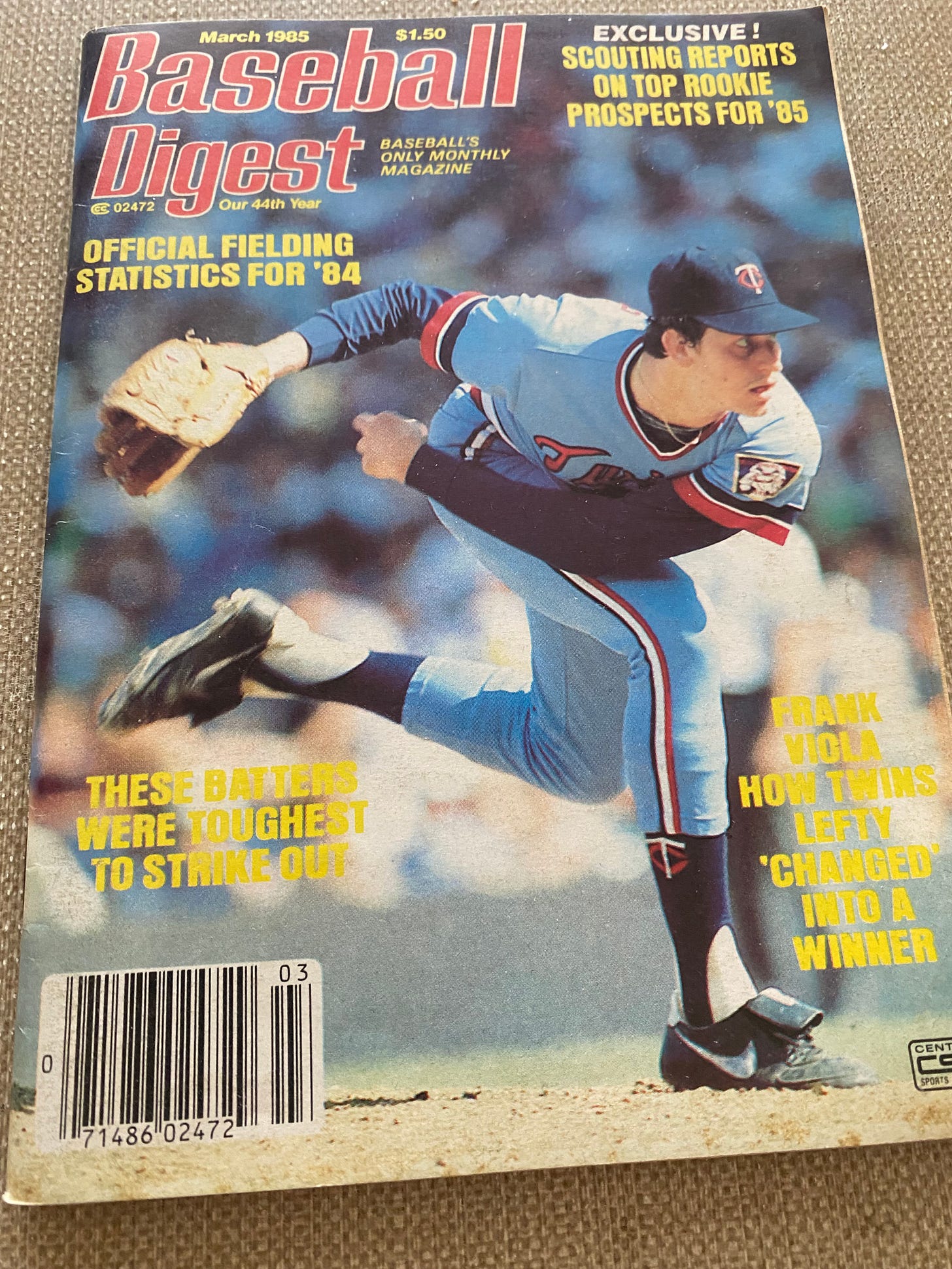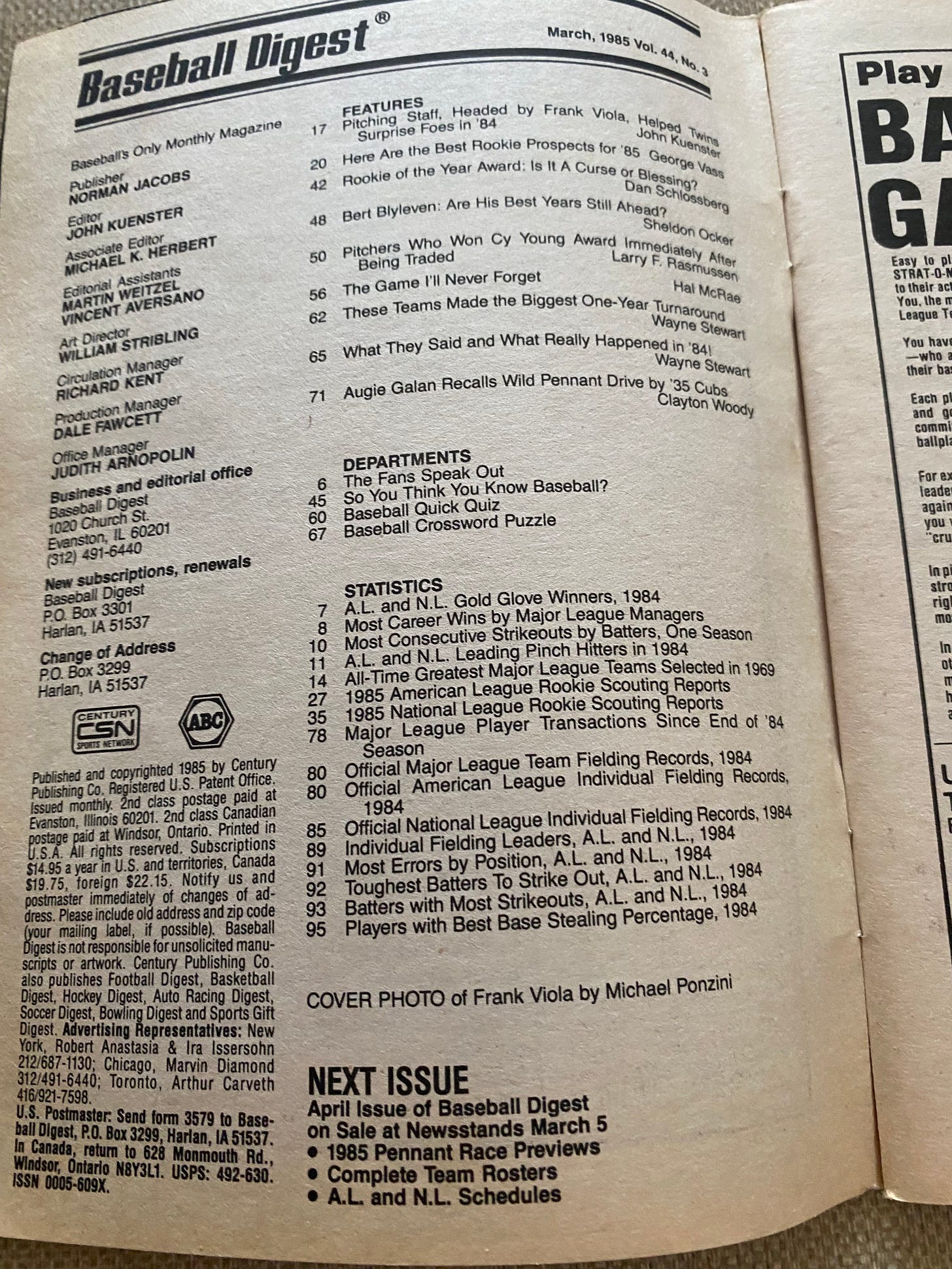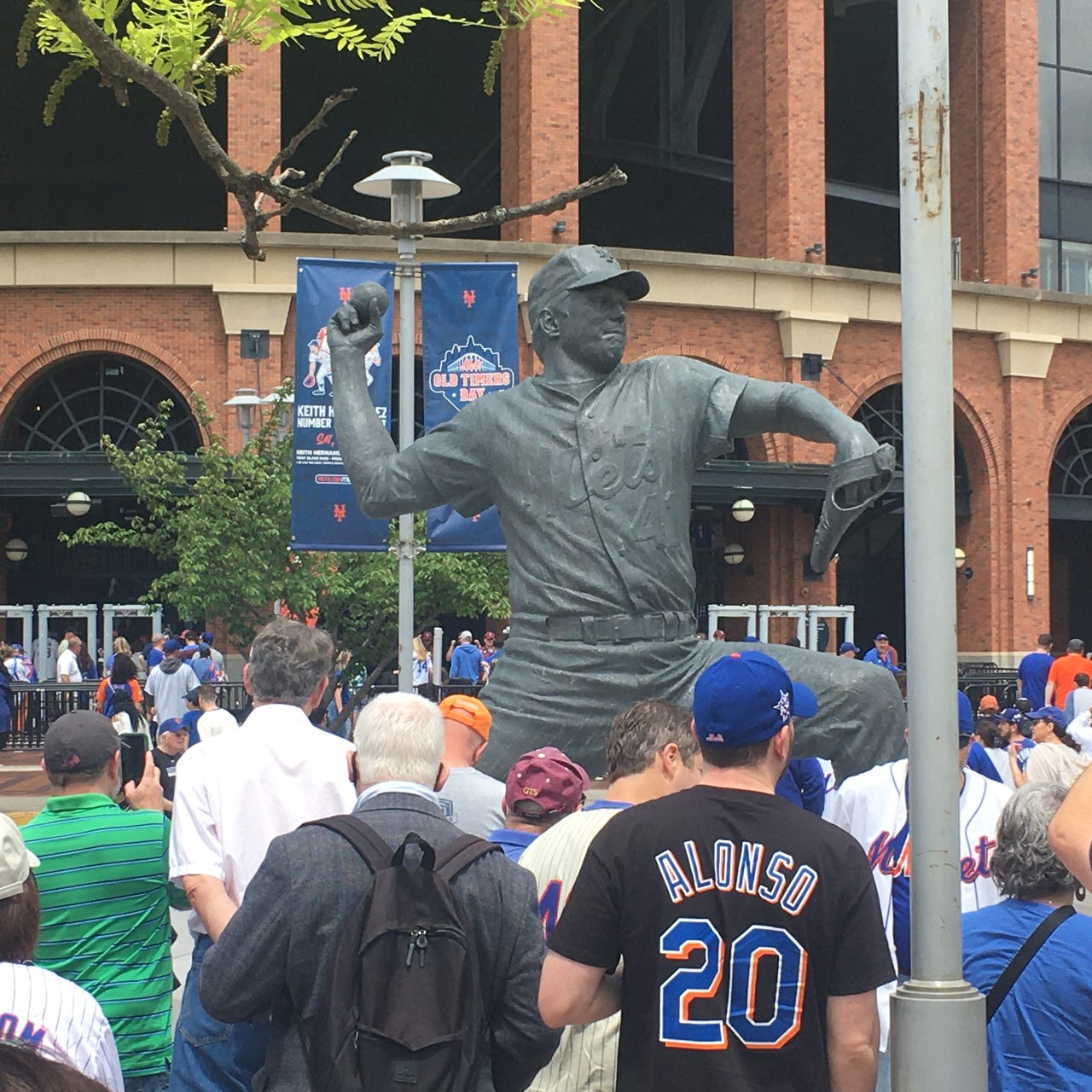March 1985
Last week I was taken aback by a cover photo of a mustachioed Steve Carlton. This one was the flip side; the cover features a photo of Frank Viola sans ‘stache. Or at least sporting one so thin and wispy that it’s barely visible in the photograph. I could have sworn that he emerged from the womb with facial hair, but I guess I was wrong. The feature story described how the Viola led pitching staff brought the Twins to a surprising .500 record in 1984, with the expectation that there would be more wins to come. Kinda sorta. The Twins took a slight step backwards in ‘85, but Viola would turn out to be the ace of the staff when they won the 1987 World Series. On the other hand, Viola was the only member of their 84/85 pitching staff who had much to do with that title.
I always enjoy looking back at the annual rookie preview to see what the magazine editors got right. This time it was a little tricky, as unlike most years in this issue they did not appear to rank the top prospects team by team; instead they were listed in a random order in each team’s section. The prospects that were singled out in the article’s subheading were: Danny Tartabull, who was then a shortstop, Ozzie Guillen, who went on to win the AL Rookie of the Year award, and Neal Heaton, who spent more than 10 years in the majors but was never much more than a league average pitcher. The 1985 NL rookie winner was Vince Coleman; the magazine did not think much of his chances as a prospect, stating that he probably needs another half season playing AAA ball.
Are Bert Blyleven’s best years still ahead? Yes and no. 1985 was his age 34 season, so he was theoretically in his decline phase, but he was also coming off of a 1984 season in which he won 19 games. He had a big 1985 as well, leading the AL in 5 different categories, including shutouts and strikeouts. He would also be traded to Minnesota at the trade deadline; he was the co-ace with Viola on the aforementioned 1987 champions. So, he had some very good years ahead of him, just not his best.
An asterisk should go with the article that listed the best one-season turnarounds of all time. At the time the honor belonged to the 1946 Red Sox, who won 33 games more than they had the previous year. There is an easy explanation for that improvement; all of their stars returned to the team after having served in World War II. The same could of course be said for every team in the league, but in any case the rosters from one year to the next were so radically different that it’s really an apples to oranges comparison. They don’t hold that record anymore anyway. The 1999 Arizona Diamondbacks won 35 more games than they had the previous season.
Finally, this caught my eye in the letters to the editor section. Most of us are aware of a poll conducted in 1969 centered around the 100th anniversary of the first professional team which named Joe DiMaggio the greatest living player. It was after that designation that DiMaggio demanded he be introduced as such before every personal appearance he made for the remainder of his life. Here is the rest of that poll, including the full all-time team as well as the full team of living players. I don’t want to get too heavily into the nitty gritty, and it goes without saying that no one voting in a poll conducted in 1969 would think to include Negro Leaguers but… George Sisler tied at first base with Stan Musial? Bill Dickey at catcher ahead of Yogi Berra? I can maybe see leaving Henry Aaron off at that point in his career, and who would be knock off if he was included? And I know that at the time writers appeared to highly overrate one guy and highly underrate the other but Pie Traynor over Eddie Matthews at third base is indefensible. Brooks Robinson would have also been a better choice than Traynor, although the vote took place before his magical 1970 World Series.
Most Memorable Moment - Los Angeles Angels
MLB’s Original 1976 Choice: Nolan Ryan’s 4th No-Hitter
My Updated Selection: Nolan Ryan’s 4th No-Hitter
Of the 4 1961/62 expansion teams, the Angels had the most immediate relative success. They finished above .500 in only their second season, and although they soon devolved into a consistent second division club, they were rarely extremely bad. They have had more than their fair share of 90+ loss seasons; but the 99 games that they lost just last year is the franchise nadir.
Their history is filled with an inordinate amount of bad luck, if not full-on tragedy. There used to be multiple mentions of a so-called Angels curse, due to a combo of career-altering injuries to promising young stars as well as tragic deaths of a handful of active players. Even now, some of the first things people think of are the all too frequent failures, most notably Game 5 of the 1986 ALCS when Dave Henderson hit a game tying 9th inning home run off of Donnie Moore when the Angels were only 1 strike away from winning their first pennant. That home run opened the floodgates; the Red Sox would go on to take that series in 7 games. Sadly, Moore would later be added to the list of Angel players with tragic fates, having taken his own life only 3 years later.
And of course the chief talking point in resent years is of how the Angels have completely squandered Mike Trout’s career as well as the years in which Shohei Ohtani was on the team. I could almost say that the most memorable Angels moment was the day that Matt English posted the Tungsten Arm O’Doyle tweet. On a more serious note I was almost tempted to bestow the honor on the first time that Ohtani hit a home run in the same day that he had pitched.
Normally a moment that occurred whilst a franchise was winning its only World Series would be a strong candidate. The top contender from the 2002 WS would be Scott Spiezio’s momentum shifting home run in game 6. It was huge, but to me it would have been different had it been a game tying homer or if it had brought them within 1 run. Instead, it cut the deficit in that game to 5-3. Close, but no cigar.
Instead I will stick with the same moment that MLB chose back in 1976. In 1975 Nolan Ryan tied Sandy Koufax’s record with his 4th career no-hitter, this time defeating the Orioles 1-0, striking out 9 and walking 4. Needless to say he had a pretty hefty pitch count; counts were not officially tabulated at the time but reports state that he threw 147 pitches that day. In a nice coincidence this was also his 100th career victory. Ryan wasn’t done, he would hurl 3 more no-hitters in his career, yet another one of those records which is almost certainly unbreakable.
I could probably be talked into switching my choice to the Spiezio home run, but I believe the historical significance of Ryan’s feat along with the fact that he was the signature star from the first quarter century in Angels history is enough to tip the scales for me. It looks like the game was not televised, so there is no footage to share. This is the closest thing I could find.
TV Of the 21st Century - Freaks & Geeks
This is mildly cheating, as Freaks & Geeks debuted in 1999, and since it was cancelled after only one season, it had more episodes which aired in the 20th century than it did in the 21st. No matter, my newsletter, my rules. I will allow. Although it only had a brief run, it is it the top of the list of all-time one season wonders. The show was sharp, funny, moving, and it introduced the world to a group of wonderful young actors, almost all of whom would go on to become major stars.
Created by Paul Feig and produced by Judd Apatow, F&G was set in a Detroit suburb in 1980. The lead characters were the Weir siblings: Lindsay (Linda Cardellini), a former mathlete who following her grandmother’s death fell into a despondent gloom and chose to reinvent herself by hanging out with the stoners, AKA the freaks, and younger brother Sam (John Francis Daley), who proudly stuck with his fellow nerds, AKA the geeks.
Part of the reason why the young cast went on to bigger and better things is that Apatow continued to cast them in his subsequent projects, but one can also say that this proves he has a great eye for talent. The other freaks were James Franco (the brooding heartthrob), Jason Segel (the wide eyed romantic), Seth Rogen (the sarcastic bully), and Busy Phillips (the jealous mean girl hiding the fact that she came from a broken home.) The other geeks were Samm Levine (the self-aware guy) and the always spectacular Martin Starr (the übernerd.)
The brilliance of the casting extended beyond the main teen characters. Joe Flaherty was outstanding as the Weir patriarch, quite possibly the most irritable TV dad in history. Thomas Wilson channeled his old Biff persona as the high school’s PE teacher and basketball coach. Dave “Gruber” Allen was the hippy-dippy guidance counselor. There were even more future stars to be found among the recurring characters attending McKinley High. Look, there’s Ben Foster. Did I just see Rashida Jones? Hey, Lizzy Caplan goes to this school! Was that Shia LaBeouf in the mascot costume?
It’s true that there’s a little bit of both freak and geek in each one of us - there was a great episode in which Franco’s Daniel drops his defenses, plays Dungeons & Dragons with the geeks and loves it - but it shouldn’t surprise anyone who has seen how much I enjoy writing about comic books that I related to the geeks. Sometimes things hit a little too close to home for my comfort. In the pilot episode Sam struggles to gain the confidence to ask the girl he has a crush on for a dance, all while Come Sail Away plays. He finally does so and walks her onto the dance floor at the exact moment that the slow portion of the song breaks into the hard rocking closing portion and he was temporarily frozen wondering what to do. And the episode in which he confidently struts in the locker room wearing a jumpsuit before he realizes what a horrible fashion choice he made? I’m not saying that something similar never happened to me, but then again I’m not not saying that.
Of all the characters none stood out quite like Martin Starr’s Bill. Over the course of only 18 episodes they revealed so many layers. One of the most famous scenes in the show was a montage that showed him as a latchkey kid alone in his house making himself a sandwich and finding absolute joy while watching a Garry Shandling standup routine on his television.
NBC never knew what to do with the show, constantly bouncing it around the schedule, eventually pulling the plug before they even had a chance to air the entire series. Some, but not all, of the episodes would be burned off on cable, and it was not until the DVD release that the complete series was available in its entirety. Having said that, the final episode of the one and only season ended in such a perfect way. Yes, there were plenty of stories left to be told about these people, but the conclusion of the season felt like the closing of a chapter.
The show has developed a significant cult following, which significantly grew with each major project from one of the show’s vast alumni network inspiring new fans to revisit F&G. Even better, the original music remains on streaming platforms; some of the specific musical cues were so crucial to the plots that something would have been missing had they been substituted with a generic rock score. Freaks and Geeks was a treasure; it may have been set in a specific time and place but the themes were timeless. This is a show that everyone needs to experience. Apologies for the over abundance of clips that I shared, but it was that good.
Originally aired on: NBC
Currently streaming on: Paramount Plus & Prime Video
Closing Laughs
That is enough for now. Guys, you don’t need me to tell you that things have gotten significantly darker much more quickly than many of us have feared. I don’t want to default to “this too shall pass” type comfort. Things could still get worse before they get better. Let’s stay strong and stick together. Try your best to have a great day. See you on Wednesday.







